

Portfolio
Kameiko Karyna
identical place the person forms the enviroment the enviroment forms the person
person

AI architecture concepts
Working projects, 2023-2024
Individual project



Under the sand project in Morocco desert
Study Lund project, 2023
Group project with Maria Tani

Nursing centre in San Francisco


01 M
Museum of Traditional Culture in the «Yelnya» Reserve

Bachelor thesis, 2022
Individual project

Social settlement for homeless people in Novorossiysk
Working project, 2021
Individual project
05 B
Beirut Collective
Competition project, 2021
Group project under my leadership: creating concept , drawings, architecture 03 S
AI architectural concepts in work/study
Individual work, 2023-2024
As an architect, I am constantly seeking ways to push the boundaries of design, innovate solutions, and optimize the built environment for the benefit of clients and communities. In this pursuit, I have found that integrating artificial intelligence (AI) into architecture design processes is not just advantageous but essential in today’s rapidly evolving landscape. There are several projects in different parts of the worlds, which were made to present architectural proposal to clients. All of them were made by AI + Photoshop AI. Throughout this way of searching the main principals for architectural concepts, time for trying different appoaches were reduced ,and created not 2, but several concepts for one place.
As I continue to integrate AI into my architectural practice, I am excited to explore its potential to push the boundaries of design and shape the built environment for generations to come.







Museum of traditional culture in the «Yelnya» reserve
The UN report proved that since 2000, people have been 100% responsible for global warming.
What are we doing with our environment?
My thesis project I started with a search for artifacts of nature, where a true and сareful relationship with a person has survived. «Yelnya» is the place where my friends and I come back every year to be with nature. The object of design is the territory of the reserve, located in the Republic of Belarus, the Vitebsk region, partly in the Miorsk and Sharkovshchin region, organized in 1968, which is part of the Ramsar Territory of Belarus. After reclamation measures, the swamp lost more than 50% of its water supply, resulting in increased human exposure and fires. The biggest fire occurred in 2002, damaged 70% of the territory.
The purpose of the project - to limit human exposure by creating tourist routes of different directions, the creation of tourism ways- museum routes, design of amenities and tourism facilities aimed at human interaction with the nature of the swamp «Yelnya» through the cultural and historical features of the Republic of Belarus, Clear delineation of human activities on the territory of the reserve. The ultimate goal of the project is to catalogue objects located on specific routes, which in the future can be used in other protected areas where there is a marsh.


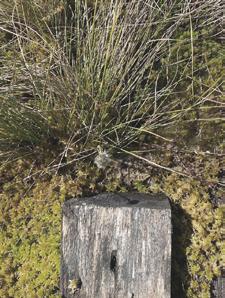






mental map - my first trip


What is the swamp?










Different countries are trying to conserve and increase the biodiversity of their countries to improve the quality of the environment.
Swamps are a broad-based type of land. Unlike forests, 1 hectare of natural wetlands emit 2 times more oxygen and 4 times more carbon dioxide than forest. Swamps exposed to humans (fire, drainage, pollution) emit carbon dioxide as one machine and four times more methane than rice fields.





Swamps consist of four main layers: sfagnum moss, clean water, peat, mineral land. What forms a swamp? Peat and moss sphagnum form different types of swamps. Moss sphagnum forms a moss carpet, holding water, and their dead roots shape the deposits of peat.
The world is faced with the problem of drinking water, and the swamp is a natural source of drinking water, and the moss sphagnum has a protective effect, which is enjoyed by locals.

sphagnum carpet
sphagnum moss

carpet swamp base

mass of sphagnum dry sprouts from 50 to 250 grams

mass of 1 sprig of wet sphagnum from 50 to 250 grams
 sphagnum
sphagnum







Existing populated place


Existing water system
Existing natural system
Existing natural system
Mannual canals (reclamation)


Existing water system before reclamation

Existing topography
Anthropological impact

Does the person forms the enviroment?
First range zone
prohibition of people due to the habitat of the red book animal natural type of the swamp - untouched
Second range zone
















water balance
mannual dams
- area of the fire



Person forms the enviroment
Who is the person?
Kids Tourism
Teenagers
Adults
Riterees
Researching/Voluntaring
Secirity / Administration
Locals/life in the swamps
Festivals (bicycle)
When is the enviroment?
30 Apr.
Administration
Monitoring
Sensation as land
What is the swamp’ culture?
Swamp’ culture
Work at the site
Harvest
Research at the site
Researchers/Voluntarees
Administration
Locals
What is the architecture?






30 Oct.
Sensation as swamp
Someotne is gone Locals
Keepers
Traditional culture Carriers
Swamp’Culture bearers
Informational carries
Swamp’culture
Routes
Routes from Keepers Getting information through tours from keepers
Architecture Scenarios with traditional motives
How to built architecture in the swamp


Independent tourism
Architectural assistance: Weawing/Wooden construction/Textiles/Moss
Wooden modelar construction

 Keeper (Kasya)
Swamp vegetation
Biotextule
Wicker structure
Keeper (Kasya)
Swamp vegetation
Biotextule
Wicker structure






Architectural scenarios forms the enviroment - stations - 1, 2, 3, 4, 5, 6, 7, 8, 9, 10












Entering






Observation
Observation towers/tower for birds













Silence Place for meditation and recreation







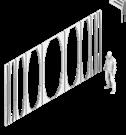














 swamp creatures connect through architecture
Culture centre
Observation tower
swamp creatures connect through architecture
Culture centre
Observation tower




Yelnya is a unique and mysterious place in Belarus. And in this particular place, there are beliefs, mythology and culture, which are now stored only in the memory of people. In my project, architecture became part of mythology, opened the door to the subjective swamp world.
Swamp architecture, created with the help of a special design, is able to embody the structure of swamp moss sphagnum and immerse a person in an unusual environment.
Just touching the moss, people are facing a 14,000-yearold story. What she’s saying, what stories a person can hear if they’re immersed in this journey. Architecture is not just a way of harmonizing the environment - it is a way to convey history and create it.


Under the sand project
in the Morocco desert
We are living in the era of global changes; our planet is changing too. According to National Geographic global warming is predicted to increase the area of desert. However, nowadays the desert covers up to 20% of earth’s areas. Architects should change their concepts in the changing time.
Due to the extreme conditions in the desert people have had to build shelter that can deal with these conditions to be able to survive. There are several passive architectural passive strategies we can use in order to create more comfortable living for the human body. Some common things we use in hot arid climates to help with climate are for example zoning, building orientation, evaporative cooling and different types of shading.
By looking beyond humans and into nature we can discover great approaches, which architects could implement in projects, for instance termite mounds with their passive ventilations system that has inspired Eastgate Center, a retail and office building in Harare, Zimbabwe.
Our concept for this project was to build underground in order to provide a comfortable temperature for sleeping. There are 4 main starting points of this project: dessert, water, thorny devil and termite mounds. The aim was to build something that felt like it belongs in the desert unlike a normal building.



The primary motivation behind the project was to investigate the use of digital tools in the design process, allowing our exploration and the challenges we encountered to shape our decision. The starting point was the desert, aiming to develop architecture with a program for the inhabitants of the desert. Our project concept involved constructing an underground structure within the desert and it would offer a cool and comfortable sleeping environment. We drew inspiration from the thorny devil and termite mounds, seeking ways to address the challenges of a hot climate. Our goal was to create a structure that felt like it belonged to the desert landscape. Through this project we have explored domes and interlocking brick and the capabilities and constraints of Grasshopper. The project offers numerous opportunities for further exploration in all its facets, which is one of the exciting parts of it.



We did a water analysis and found that it Merzouga there is a water reservation under the desert which makes it a good site for our project. The plenty of plants can be found in this place.
Desert sand
In order to place our construction we needed to know how sand moves, the most common wind direction is -NE. Temperature under sand between 18-20 degrees. By doing site analysis we felt that Merzouga is a place that combines city and desert - made seans to project.



UNDER THE DESERT



Thorny devil
Thorny devil absorbs water through its skin , the pattern helps to distribute water. We took the idea and created water absorbing panels to provide humid air, more comfortable living conditions.
Termite mounds
From termite mounds we were inspired to go underground to find comfortable temperature and found also their way of construction inspiring, the flexibility to grow and adapt and what they leave behind, using natural material


The mid review concept Using «spherical» form

Connect two domes «The hat». Use interlocking system

EVALUATION OF THE FORM


FAILURE OF THE SHPERICAL FORM
SUCCESSFUL ONE DOME
Simplifying the bricks
Vault Catching water outside
Collect water inside




FAILURE OF ATTACHING INTERLOCKING PATTERN IN TWO CONNECTED DOMES
RESULT



RESULT
RESULT
The result is a building or structure which can be found in different desert conditions where there are sources of water, built by interlocking bricks with water absorption panels. The structure would use the courtyard as a focal meeting point serving to unify the entirety of the building structure.
This structure is something flexible in the way that you can live there for weeks, months or years
and the building or buildings can adapt depending on the inhabitants and how many domes you build and use. Living in these structures could be a family or collective or village.
The building/ structure is several units in the same size interconnected together to create the building. The units are domes with a curved floor. There are four main functions that are located in the building:
Courtyard - created by the form of the building and make the space for meeting outside.
Kitchen - is situated in the ground level domes and can be entered from the courtyard. The domes have no “hat” on the roof to provide ventilation for cooking.
Living area - the areas between sleeping capsule and ground levels, also as tunnels. There are dunes on ground level that provide the same function. Sleeping capsule - located under the sand to provide comfortable sleeping conditions.

REFLECTION
what will we leave behind?


One of our reflections from the beginning was, what is the lifespan of our project and what death is waiting for this building? Our prediction is that for the first 10-20 years the structure can absorb water and make more comfortable conditions.
However after the effects of water on the structure, we predict that it will destroy the building and it will die naturally. It can become a new landscape with a different function like the sand catchers or a new rock.

Further reflection on modern technology such as digital fabrication and computation methods, we as architects are able to reproduce materials on a newer level: to recreate not just the structure, but also the connection of material in space.
We hope that it brings new opportunities for the desert.

Social settlement for homeless people in Novorossiysk
Temporary house can be new chapter in live. The village near Novorossiysk is a social project for vulnerable groups who lost their houses. Its vision is to create an environment in which people and families who, for one reason or another, find themselves homeless can go to rehabilitation, work and recover from their social situation.
In modern society, events often occur that deprive a person or family of housing without the possibility of moving to another place, thereby forcing a new start in life. The task for me as an architect, was to organize an environment that allows a person to undergo social rehabilitation in a painless and comfortable way, to get qualified help, to master new specialties and, as a result, to gain confidence in their ability to leave the village solving their main fears and problems.
However, in addition to a comfortable environment made in connection with nature, the environment in community should motivate a person to normalize their life and leave it, so apartment spaces have common kitchens, individual houses of extremely modest size with only a zonal division into blocks of bedrooms. In this way, easy domestic discomfort acts as a motivation to help a person get on his feet and take responsibility for his life again.



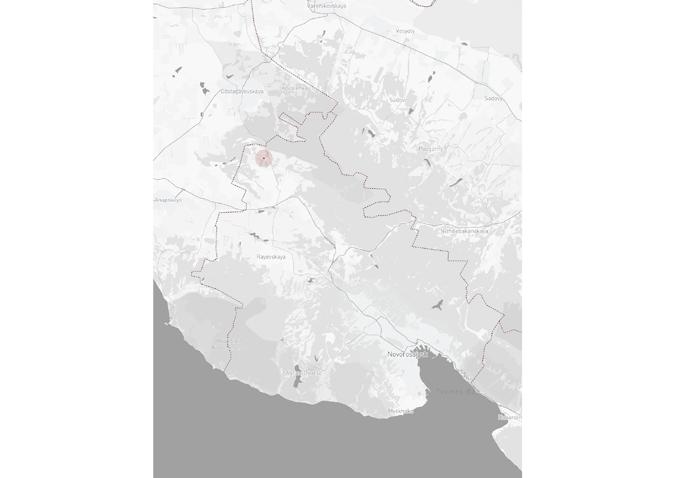

Novorossiysk is located in the south of Russia and these conditions helped to form the concept of modular houses made of wood, not needing finishing. Thus, a minimum living space was calculated, which helped to calculate the number of people able to live simultaneously in the village.













Center general house

In creating the concept of the whole village, it was important to create a semi-enclosed settlement that could operate autonomously without communications with the city, but at the same time contributing to the development of the inhabitants and reviving the desire to renormalize life outside the village.
Thus, the concept of one ring road, which serves as a guide to the main house of this mini-city, was developed. The main house is filled with 5 main functions: a welcome area where upon arrival people can get the keys to their new home, a recreation area inside the building with the gathering of all residents on the steps in the open air, as well as a work area and utility area, and residential apartments. It is important to note

that to socialize and normalize life with the nearby city, three types of work were created: handicraft, carpentry and gardening. The rooms for crafts and carpentry are located in the main building, with locker rooms. And each individual house has a place for gardening. The settlement’s policy is to encourage sales of products in the city, where 70% will be given to the creator, and the other part in the form of 30% will work as a rent for their housing. In the main house there are 4 apartments of common residence such as colising. The apartments have a common area with kitchen-dining room with 3 to 4 rooms with double and single beds. All apartments were created with minimal living space to encourage moving into a separate house, and then completely leave the village.

Three types of houses A house
Family with 2-3 children



B house
Family with 1-2 children
When the first stage of living in an apartment is over, people can move into their own home. A total of 3 types of individual houses have been created depending on the number of people in the family or the absence of a family.
Type A houses are located in the area of the park and children’s playground. Because this type of house can be used for the family with the largest number of children.


C house


Type B houses are located in the central zone of the entire village and have an important feature - a common alley with common gardens, which can facilitate communication between people. Therefore, this type of house can live as two couples and a family with adult children. It is possible because of the attic half-floor.
Type C houses are a remote area and specializes in cozy living and work in the most important house. It can be a couple with a child or several people without a family. This type of house has the largest area because of the possibility to convert the house into a comfortable residence for very large and different families, not needing full socialization, but wishing to normalize their lives.

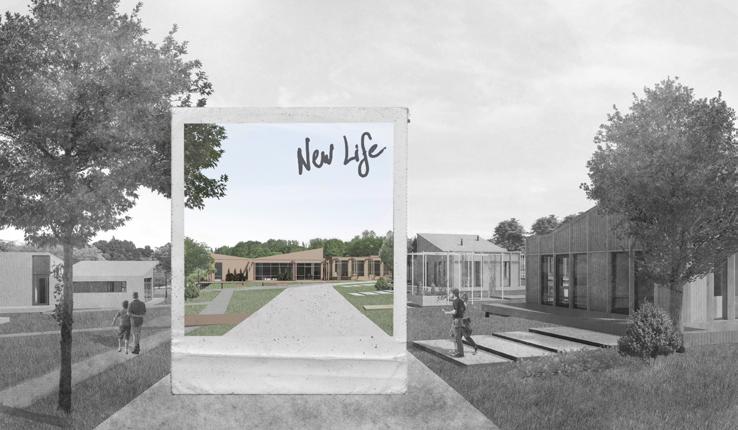




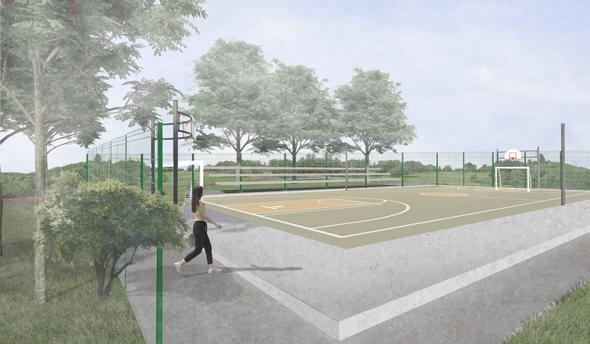
Temporary house can be new chapter in live.
In addition to comfortable living such as houses and main building some places have been created in the village, such as an entrance stand for acquaintance with the history of the village and important information, a place for yoga and meditation near the main building, a playground, a sports complex with the latest equipment, the main alley, steam paths and a place of solitude in the landscaped. These places can become places of new friends and new memories. No one is immune to terrible situations, but it is in our hands to help each other overcome them. The village near Novorossiysk is not just a project, but a concept of life.

Sonoma grove, nursing centre in San Francisco 04
Working individual project, 2022
Old age or sickness is not the end of life, but the point to start all over again. This motto was the basement of the Nursing centre in San Francisco.
The center now has one building and 20 rooms in it, but with the increasing percentage of people in need of special care, the management decided to create a new building and transfer equipment to it, leaving the old unsuitable building for household needs. Also, an important task was to make the new housing modular. This was the idea to create a model design for a building that would be universal to other places to help people around America.
During a tour of the existing area, I noticed a large oak park and a garden with flowers next to the rooms . Also, the interior concept of the existing building consists of black-and-white photographs from the past. So, in thinking about the concept, I talked to doctors and found out that it’s the connection to the ground through parks and gardening that has a positive impact on health and a lot photographs can be a bridge for patient’s memory. Therefore, gardening can be a action for people to feel life and to heal themselves they can heal together with plants. So, I chose wood and for budget reduction it became main material for interior and exterior, also the main structural material, so as not to create additional finishes in interior design.



We are able to find ourselves in new photos

2 options



Together with the American company S2A, I developed the idea of modular serial production for the future expansion of the center across America. The centre consists of 4 modules: an active zone module with a dining area, a venue for events and people gathering, a kitchen module with the possibility of connecting several modules, several corridor modules and two residential units module. One transportable module



Living module’s section
Skylights are used for lighting with wooden bars, which control overheating corridors

Activity module’s section
Solar panels
















Four units of living parts were created, connected by corridor modules, which lead to the activity module with a kitchen. The modules are a universal constructor, and in this place their location are created because of the desire to save all existing plants and oaks. This created a yard between the two buildings, and each room had its own exit to the terrace or garden.

 Existing building
Existing trees
Reining walls
Pedestrian road to the park
Kitchen module
Decorative wall with main information
Existing building
Existing trees
Reining walls
Pedestrian road to the park
Kitchen module
Decorative wall with main information




When creating the exterior of the project, a wood was chosen as the basis of the entire project. Therefore, the main structures and windows are presented exclusively wooden, as well as for shading rooms in view of the hot weather in San Francisco were developed separate modules of wooden adjustable rails. The same bars are used in the interior from overheating corridors, where skylights are used for lighting. Also due to the relief, many rooms got their own terraces and the ability to grow plants right next to the room, and where the relief was too high to maintain a barrier-free environment, the rooms remained at zero, but fences were installed on all terraces, on which it will also be possible to grow plants in special pots. idual houses of extremely modest size with


Beirut collective 05

Competition project, shortlist top-10.2021
Captain- Karyna Kameiko, Arina Garbunovich, Masha Sviridova
In the capital of Lebanon - Beirut, a powerful explosion occurred on 4 August 2020. The epicenter of this explosion was the main port, surrounded by the historic city center. More than 300 thousand people lost their homes, hundreds of historical buildings were destroyed.
Most often, when creating installations related to events that are relevant to all people in the city, they are created on the basis of active interaction with the object and the location is usually comfortable only for tourists. Local residents can live in the city, but have never been to the installation. Therefore, the main task was to create something that will be primarily for local residents. In this project, these are objects that require only passive interaction.
Memory activation through unexpected objects in familiar places.
Rebuilding the city through meditation while collecting the pieces of wood that preserve its memories.
No one can renovate an entire city alone. Restoring the lost collective memory is a task for all residents of the city. They are a COLLECTIVE (not only I, but I + We). They can collect the city piece by piece from the fragments of wood left after the explosion.
Collective memory is the strongest. As long as it exists, we are able not to make the same mistakes.History is what we can rely on now.

home collect

Beirut

explore on 4 August



different group after explore memory


HOME



How to make it? Materials:





- Wood chips of various sizes, as well as bricks, tiles and other fragments found in the area;
- Map of Beirut / region, scale 1: 1000, 1: 2000, 1: 5000;
- Base solution;
- Any surface;
* The surface can be coated with epoxy or similar to make it smooth if desired.
* To simplify the creation of the map, it is possible to use wooden formwork in the form of a box, where the boards will be stacked
* Created groups of people from 2 to 5 people will create 1 object in 4 hours pieces of past life wood which volunteers collect doors, frames, chairs

